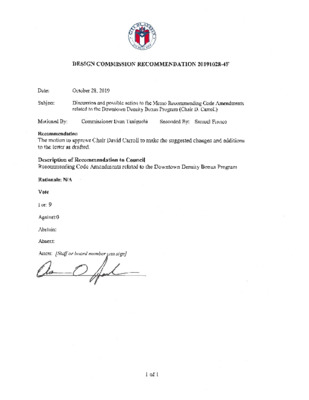OUTDATED 20191028-4F: Design Commission recommendation to City Council for DDBP — original pdf
Recommendation

1/2 DESIGN COMMISSION RECOMMENDATION Date: October 21, 2019 Re: Land Development Code amendments related to the Downtown Density Bonus Program Honorable Mayor Adler and City Council Members, In Austin, high-rise projects that comply with the current Downtown Density Bonus Program (DDBP) can be awarded over three-times the floor area than the base zoning allows in exchange for what today are considered modest design improvements. The Design Commission is a strong advocate for downtown density, but we are also finding that the DDBP has become dated and does not create public benefits comparable to the entitlements that these projects receive. We are specifically concerned that the DDBP is not well aligned with the more recently adopted policy goals including: mobility1, pedestrian safety2, climate and sustainability3, livability and affordability4. For example, a developer may approach the Design Commission with entitlements for an eight-story commercial building, and if compliant with the DDBP, walk away with the ability to construct 24 stories of hotel space (hundreds of units), and 8 stories of parking (thousands of additional parking spaces), in exchange for modest street level improvements5, and perhaps somewhat more energy efficient building design6. The Downtown Density Bonus Program’s gatekeeper requirements do not account for: • Design for ride share queuing and associated pedestrian safety • Public access to structured parking garages or parking demand management systems • Parking structures designed for future re-use as livable space • Downtown mobility planning, i.e. support for alternative mobility options through funding, and discouragement of parking structures, especially if not designed to support transit system. To this end, the Design Commission respectfully requests that Council consider a resolution directing the City Manager to assign multi-departmental staff7 to assist the Commission in drafting proposed code amendments to better align the DDBP with the city’s adopted goals. Input from public stakeholders will play an important role in this process as well to ensure the DDBP remains functional and attractive to developers. Further, the Design Commission recommends that the process to amend the Downtown Density Bonus Program should include examining the following recommendations: 1 Austin Strategic Mobility Plan 2 Vision Zero 3 Austin Community Climate Plan 4 Imagine Austin Comprehensive Plan 5 City of Austin Great Streets Program. 6 Two-star rating from Austin Energy Green Building Program. 7 Austin Transportation Department, Office of Sustainability, Neighborhood Housing and Community Development with Capital Metro partnership. 2/2 FUNCTIONALITY • If a DDBP applicant receives a recommendation of substantial compliance from the Design Commission and afterward revises the project design, the applicant should be required to return to the Design Commission to be re-evaluated for substantial compliance. • The Design Commission’s review on whether a project is in substantial compliance with the Urban Design Guidelines should be a final determination and not left to the discretion of the Planning Director. An appeals process could be included. • Staff shall maintain a matrix of project compliance and provide bi-annual reports to the Design Commission. • Expand the Community Benefits requirement to apply to all projects opting into the DDBP. • Develop a means of alternate compliance for projects that are unable to comply with Great Streets Program requirement. This should also apply to proposed projects that already have Great Streets in place. MOBILITY & SUSTAINABLE DESIGN • Above-ground parking structures should count toward a project’s Floor-to-Area Ratio (FAR) while underground parking structures would remain exempt. The purpose of this would be to incentive underground parking and promote pedestrian activity at the ground level. • All additional parking achieved through the DDBP should be made publicly accessible, and designed for demand management. Additionally, parking awarded through the DDBP should be capped at a 50% increase, unless adjacent to a current or planned transit facility. • Community Benefit options should be expanded to include mobility features to support biking (such as indoor storage) pedestrian safety/comfort, management of off-street parking, and ride-share loading • Non-residential projects should pay an appropriately calibrated fee-in-lieu (current fee is set at $0). A portion of this fee should be earmarked for pedestrian safety and transit facilities. AFFORDABLE HOUSING • If an applicant does not provide on-site affordable housing units (and chooses to pay fee-in-lieu), they should be required to file a restrictive covenant agreeing to provide additional Community Benefits. • Access to downtown amenities through transit removes barriers to families of all income levels and people of all abilities. Funds collected from the DDBP projects may support downtown area transit supportive facilities (for example: shade structures, public restrooms, drinking fountains, bollards, green space). We appreciate your valuable time and attention to these issues. As volunteers, we are committed to providing you with professional recommendations to ensure the City of Austin is cultivating a first-class urban environment, accessible to all. With your support to advance these Code amendments, we can incentivize the development community to invest in projects that maximize the attractiveness of the pedestrian experience while designing for mobility innovations. Sincerely, Chair David Carroll, AIA City of Austin Design Commission